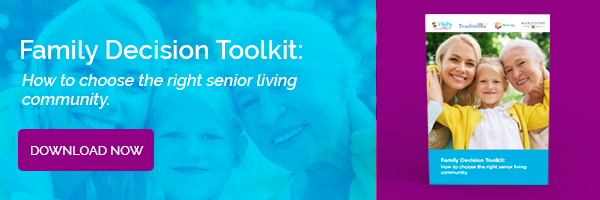Caring for an aging parent on your own can be both rewarding and all-consuming. Making medical decisions, managing financial matters, and tending to daily care often become increasingly stressful and exhausting as time goes on.
Knowing when to seek help is an important part of the caregiver’s role.
Accept that All Family Caregivers Have Limits
The role of primary caregiver can be a tough one. Siblings may want to help, but live far away. Neighbors and friends may be supportive, but busy with their own families. Even with emotional support and frequent assistance from friends and family, caregivers may still feel overwhelmed.
Recognizing your own caregiving limitations isn’t easy. In fact, many caregivers try to deny their feelings, and ignore the signs of caregiver burnout.
Discuss Options Even Before It’s Time to Make a Change
It’s important to discuss senior care options together with your parent before the need becomes urgent. That way, you can take the time to find the best fit—one that makes both of you happy. You’ll also have the chance to tour different senior living communities and find one that’s a good fit—the one that most feels like home.
Signs You Need Help Supporting an Aging Parent
Sometimes a senior loved one experiences a major medical event that makes it very clear they need a different kind of care. A stroke, a fall, or loss of mobility can sometimes mean they require more care than you can provide at home.
Very often, however, the decline in a senior’s health is more gradual. As your parent ages, small changes in behavior can go undetected. You may not notice, for example, that your mother now has trouble buttoning her clothes or lifting heavy pans in the kitchen. She might lose interest in her favorite hobbies without your noticing.
Of course, not every tiny shift in behavior means there’s a problem you can’t tackle together. But when these changes do occur, it’s important to take note and understand how they affect your ability to give proper care.
A checklist of what to watch for can be very helpful. It can provide a benchmark for assessing if you need help in your caregiving role.
First Assess then Develop a Plan
Knowing when you need help with caregiving takes a thorough understanding of your loved one’s situation. Once you fully comprehend their needs and ability to care for themselves, you will be better equipped to assist them in making important decisions.
Signs it May be Time to Look for Help for a Senior
Here are a few indicators a senior might need more assistance:
- Physical Health. Look for changes in health status, including unintended weight gain or loss, hearing problems, incontinence, balance problems, vision issues, pain, and more.
- Mental Health. Watch for decreased interest in hobbies, friends, or life in general. Also be on the lookout for signs of sadness, problems managing bills and serious lapses in memory.
- Daily Living. Increasing need for help with dressing, bathing, food prep, eating, and using the toilet are important warning signs to note.
- Hygiene Changes. If an always tidy parent now shows up at family gatherings or outings looking a little messy or disheveled, it can be a sign they are struggling.
- Medication Use. Mistakes with medications is a leading reason older adults end up in hospitals. Look for the date on each prescription bottle and compare the date with the number pills left to see if too many — or too few— remain.
- Home Safety. Falls around the home are a red flag a senior needs help. And it’s always important to remember that falls are the leading cause of disability among older adults.
Download our Staying Home vs. Moving to Senior Living Guide or schedule a tour of a community near you today!




